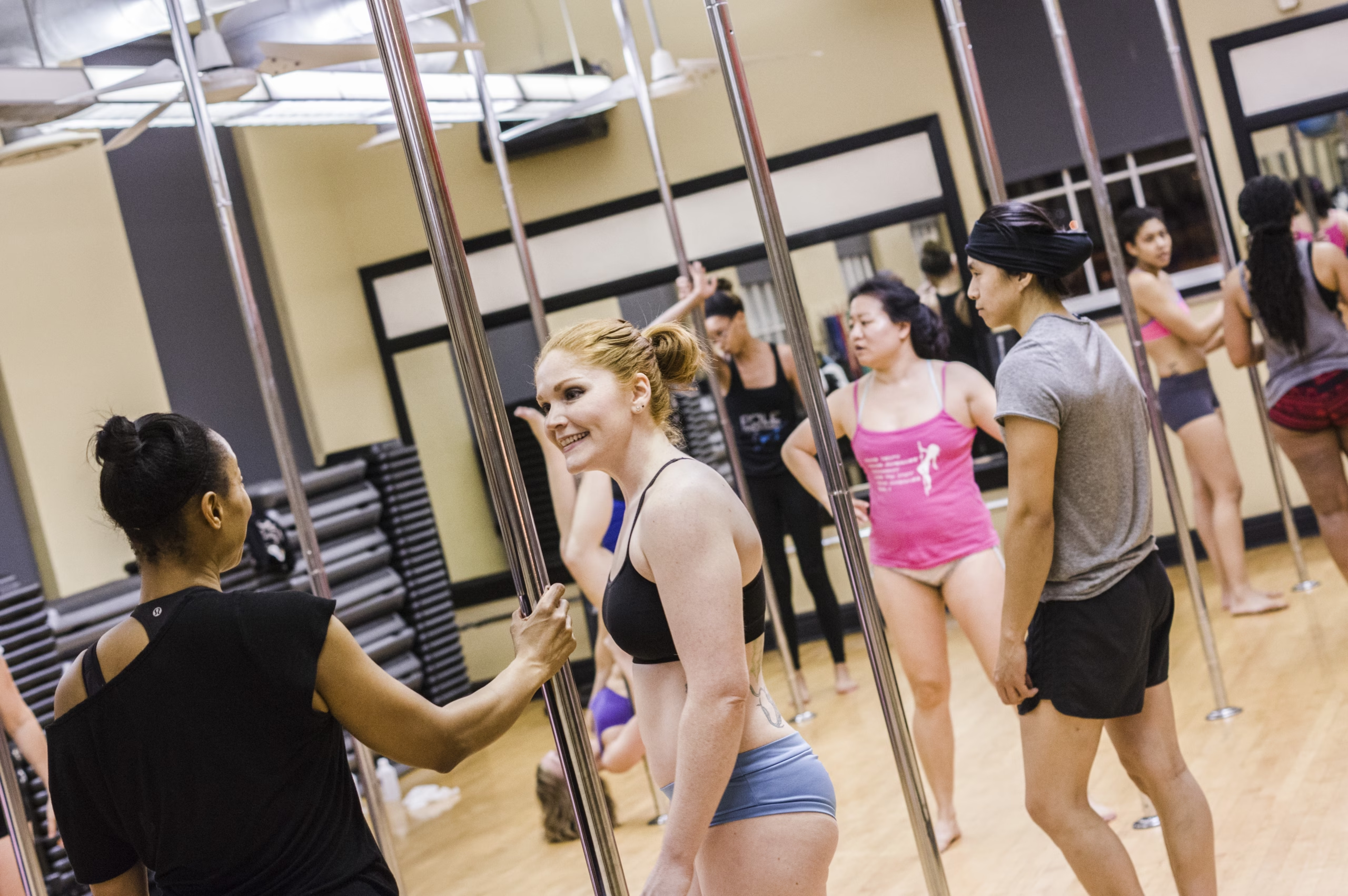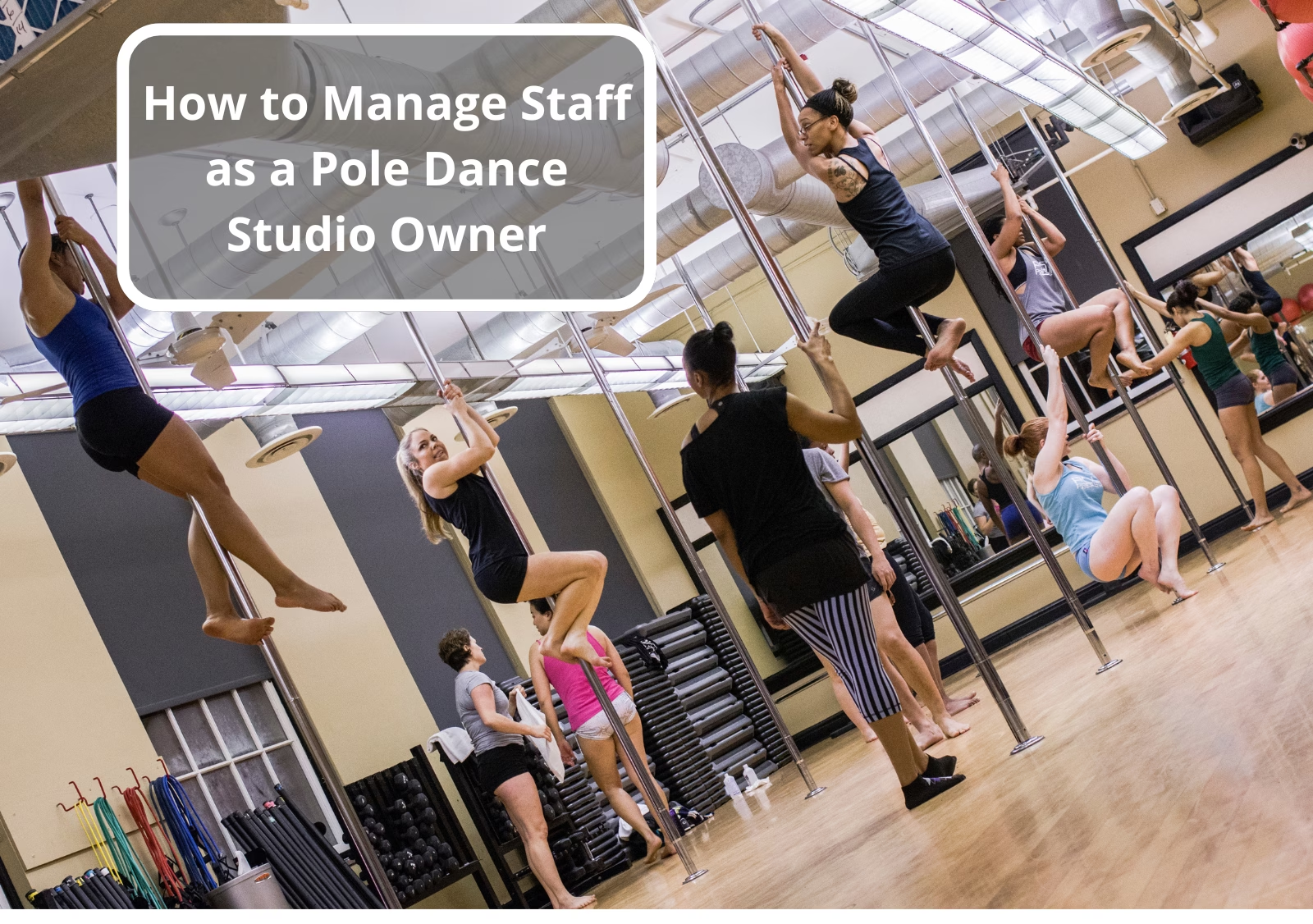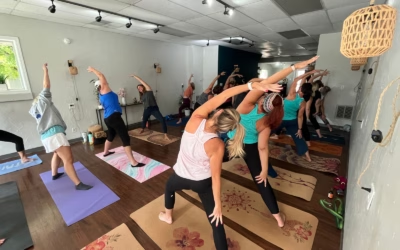Ready to begin your studio journey?
Launch your studio with a free trial of OfferingTree and start your journey off right. Build your website, offer classes, take payments, and so much more!
Editor’s Note: This post was written by Colleen Jolly, a pole dance and marketing professional, and the founder of the International Pole Industry Association.
Many people will find community through your pole studio. Which is amazing! It’s the reason many of us started studios in the first place!
Ask yourself, what kind of community do you want to foster? Remember, the stronger and clearer the “vibe” of the community, the more likely clients will keep coming back!
Your staff—from your front desk to your instructors to everyone “behind the scenes”—play key roles in maintaining the type of studio that you want to work in and share with your clients, creating that community.
So how do you most effectively manage your pole dance studio staff to support your pole studio goals?
We’ll talk about four important parts to managing your staff in this post: defining the “vibe” of your studio, why documentation matters, how to communicate what you just documented, and consider some legal stuff too.
First, Define Your “Vibe”
Of course, a good atmosphere (aka, a good “vibe”) in your pole studio is the goal.
But there’s a lot that goes into creating an intended vibe. You need to instill a feeling in your clients that makes them want to return over and over again. You want your clients to tell all their friends about your studio and post it all over social media! You need to make your clients feel safe, welcome, and proud to call your studio home.
Your staff and how they interact with each other, and your clients is a huge part of maintaining the desired vibe for your studio.
The process of deciding what type of studio you want to be can take time. You could do a formal analysis looking at your strengths and weaknesses such as using a SWOT analysis, or you could do an informal “brain dump” with a friend. Just remember to be specific in your vision because you now must communicate it—and enforce it—with your staff.
Sometimes the “vibe” can be hard to pin down since it’s about how you want people to feel. You want your people to say “wow, I want to hang out here forever!” Some ideas on how to communicate that are in your physical space—is it inviting and friendly or is it aggressive and overbearing? Lighting, wall color, and other decoration can add a lot to magnifying those traits you want people to associate with your brand. If you are a sensual-focused studio, consider soft or indirect light, warm or dark colors, textures like silk or velvet. If you’re a sport-focused studio, consider bright lights and bold, fresh colors, with textures that scream “efficient” like wood and plastic. Make sure it reflects who you want to attract—in clients and in staff!
Document it!
Now that you’ve got an idea of how you want your studio to be experienced (your “vibe”), it’s time to document it.
Create a client-facing manual for how your instructors teach and interact with your customers.
For instance, is there a specific way they should address students? Some studios us gender-neutral terms to represents students that also helps promote their brand. Just like Lady Gaga fans are her “Little Monsters” maybe your students aren’t just “students,” but they might be “Ninjas,” “Beauties,” or “Rubies” to name a few.
Some studios have very specific ways not just how to teach but what to teach while others are more flexible and allow teachers to create their own lesson plans. As part of your analysis, figure out which method works best for you and provide that information clearly to your staff.
Create an instructor-facing manual giving your staff clear expectations on the payment structure, potential career paths, what to do in case of emergency, and any other relevant processes and procedures for your studio. An “employee handbook” (even if you have contractors instead of employees) is a great way to have all your policies and expectations in one place so it’s easy for everyone to use. Consider printing out a copy of the handbook and having it available in an employee area of your studio for reference.
Maybe you think that hiring a pole instructor for your studio requires them to post on their social media about their classes. But if you didn’t make that explicitly clear, then that isn’t part of their agreed-to responsibilities. Maybe you think that tidying up after class is also part of the job, but one person’s “tidy” could be someone else’s “hot mess.” Maybe you expect your new social media manager to be available over the weekends but if you didn’t set working hours, then they aren’t going to be available 24/7. Outline all the responsibilities of the job, including working hours, and be as detailed as possible to avoid confusion.
Provide an employee handbook upon first hiring a new staff member with their training so they know how to be successful at their job. Focus on what makes your studio different from others and be clear about how you want things done to support your studio experience and community. Training should include references to the handbook so staff can refer to it for important details as they work.
Communication is Key!
Make sure you have an open line of communication with your staff where they can come to you with issues, and you can come to them with issues as well! Listen to their suggestions as they will have a different perspective than you. You don’t have to follow through with every suggestion but do make sure your instructors know that you have heard them. Not feeling heard or valued can be a major source of dissatisfaction.
Effective communication is fundamental to a successful studio, though preferences vary among individuals. In today’s digital landscape, with myriad options from text messages to DMs, crucial or time-sensitive information can easily be missed.
For rapid, day-to-day updates and urgent requests to your staff, consider utilizing dedicated messaging apps. Tools like WhatsApp or GroupMe can be more efficient than individual text messages, especially as some staff may incur costs for texts. For more robust team communication, platforms such as Slack offer a centralized space, often preferred over social media options like Facebook Messenger or Groups, which might face restrictions in other professional settings. For more comprehensive information, such as policy updates or detailed announcements, email generally serves best, allowing for longer-form communication that is easily referenced.
Beyond these general communication tools, a comprehensive studio management platform like OfferingTree can further streamline your staff interactions and management. OfferingTree provides features that complement your communication strategy by allowing for customizable pay rate rules, ensuring flexible and accurate staff compensation. It generates automatic reports detailing revenue brought in per employee, offering valuable insights into individual contributions. Each team member can be given their own account to manage their schedule and tasks, empowering them with self-service capabilities. Furthermore, you maintain full control over account permissions, allowing you to limit access to sensitive information and tailor access based on roles.
By integrating such a platform, you can centralize not just communication that relates to daily operations, but also critical administrative functions, ultimately simplifying staff management and enhancing overall efficiency.
Mutually establish clear deadlines and timelines for responses to all communications. Timeliness is a characteristic of a pole-fessional!
If you already have established timelines, expectations, and communication methods, make sure any new employees or contractors involved with your business understand those expectations when they are first hired using tools like your handbook and contracts.
Consider implementing an official annual (or other timeline) performance review for your staff which can help maintain and reinforce those expectations you set up when they were first hired. A performance review can also be a great way to gain valuable insights about your studio and to connect with your staff. It is an opportunity for you to provide feedback to them. Typically, if there is a critical (positive or negative) issue, most people deal with that issue immediately and not wait for an “official” performance review.
Having your teachers conduct a mock class or other physical demonstration of their work during the performance review is a great way to confirm they are teaching in the way that you expect. This is especially important for studio owners who are not in studio taking classes all the time to stay connected. Other people who are not teachers that work at your studio will likely not need to do a mock class, but you could have them take you through a new customer sale or other live demonstration of their job function.
Always keep a record of any performance reviews you conduct. This is very important if you have any disciplinary action issues. Laws governing employment different from state to state. Consult an employment lawyer if needed.
The Legal Stuff
Whether you have contractors or employees working in your pole studio, you need to have clear expectations for how your studio runs. Those expectations should be written down such as in an employee handbook and individual agreed to in a contract, even if it’s just an email with text and not a “formal” document!
Documentation and communication go a long way to ensuring your studio thrives.
The only people that win in legal actions are lawyers. If you have a contract that clearly stipulates conditions of employment AND how to settle disputes, it is less likely that you will go to court over an issue because you have clearly laid out the terms of employment and disputes handling in advance. Be sure to check the employment laws in your municipality—some places are more employee-friendly while others defer to the employer.
Consider adding a time-limit to your contracts so you can update and amend the details of the employment on a regular basis, as your business changes, or as your staff changes positions.
Generally, it’s always better to have a contract than not have a contract. Being clear in your expectations helps protect you and your business while creating clear lines of communication with your staff.
Even though pole is fun, remember, it is still a business. Treat your staff well, communicate your expectations clearly with them, and make sure they know they are valued. Otherwise, you may be spending a lot of time finding staff rather than retaining the ones you have!

Photographs by Lakin Jones
About the Author
With more than 25 years of international, corporate business experience, Colleen Jolly has been working in the pole industry for more than a decade in roles including studio owner, instructor, event producer, performer, and currently as the Executive Director of the pole industry’s first trade association, the IPIA.
Streamline Your Operations and Manage Your Classes with OfferingTree’s Seamless Booking Software
To streamline your operations and manage these offerings efficiently, consider an all-in-one platform like OfferingTree. It helps integrate scheduling, payments, website building, and email marketing, giving you more time to focus on your students and less time juggling tools.
With OfferingTree, you can easily set up those pop-up classes, create on-demand video bundles, and even run targeted summer promotions, all from one dashboard. This kind of efficiency is exactly what the “Small Plate” approach encourages.
To help you make the best choice for your wellness business, check out the buyer’s guide, which outlines everything you need to know about selecting yoga studio software.
Start your 7-day free trial today or explore our demo video library to explore features like automated reminders, membership management, and more.




